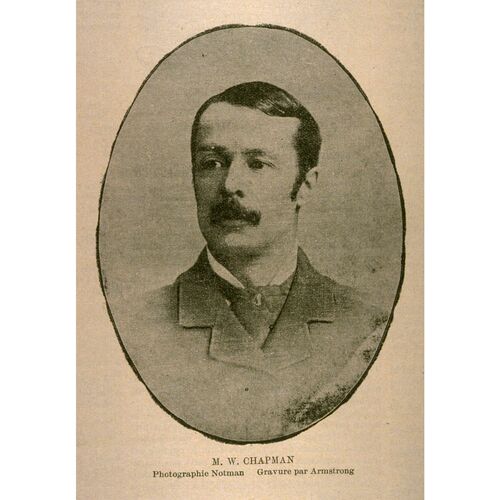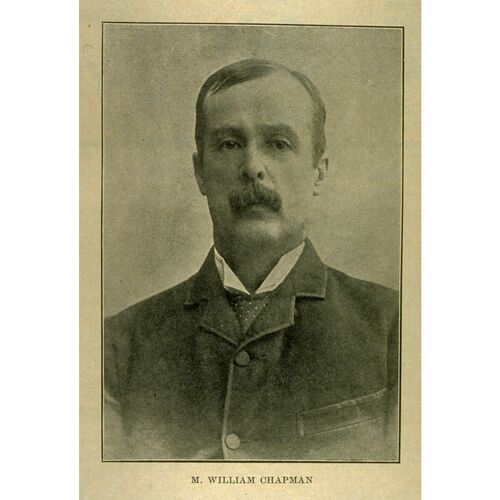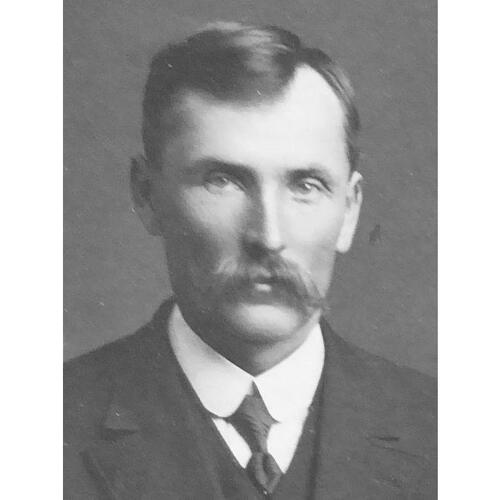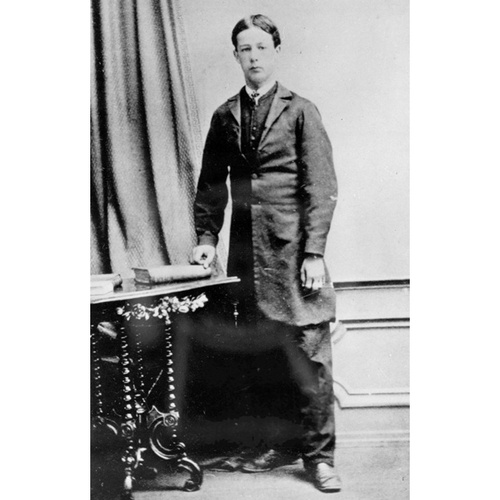CHAPMAN, WILLIAM (baptized George William Alphred), poet, journalist, translator, and office holder; b. 13 Dec. 1850 in Saint-François parish (in Beauceville), Lower Canada, son of George William Chapman, a merchant, and Caroline Angers, sister of François-Réal Angers*; m. 28 Sept. 1909 Emma Gingras, widow of Louis Coursolles, in the parish of Sacré-Cœur in Ottawa; they had no children; d. 23 Feb. 1917 in Ottawa and was buried four days later in the Notre-Dame-des-Neiges cemetery in Montreal.
William Chapman did his secondary studies at the Collège de Lévis from 1862 to 1867. In 1865, following the premature death of his only brother, Robert, who had been heading for a business career, he was enrolled by his father in the “commercial course” at this establishment, where he would be criticized for his daydreaming. The young man’s poetic ambitions were already taking shape. According to Le Monde illustré of 21 Sept. 1889, “Chapman for the first time was reading some French verse” and he had declared, “I too will be a poet.” After finishing his studies he became a notary’s clerk; at the time of the 1870 Fenian raids he enlisted as the colour-bearer in the third company of a provisional battalion from the Beauce and reportedly served at St Marys, Ont., from 26 to 30 May. In the same year his first published poem, “Reste toujours petit,” introduced the 20-year-old poet to the readers of La Revue canadienne. During the year 1873–74 Chapman was a student in the faculty of law at the Université Laval, but he would not finish his course. In 1875 he chose to enter a poetry competition organized by the university. He received a mention for “L’Algonquine,” which would be published in Quebec City in 1876 in his first collection of writings, Les Québecquoises. This book hinted at an approach that would become his editorial trademark as his ambitions grew: the vast majority of the poems were dedicated to writers who were already part of the literary establishment, such as Henri-Raymond Casgrain*, Benjamin Sulte*, and James MacPherson Le Moine. His references to Octave Crémazie*, Henry Wadsworth Longfellow (a number of whose poems he translated into French), Alfred de Musset, Victor Hugo, Louis Veuillot, Thomas Moore, and Théophile Gautier signalled the romantic, patriotic, and somewhat conservative style that would mark his writing. In his poem to Louis Fréchette*, Chapman magnanimously saluted his future rival’s return in 1871 from exile in the United States, describing him as “a great poet.”
It was doubtless the money Chapman earned during the 1870s while prospecting with partners in the gold mines of the Beauce that made it possible for him to publish his first collection. This prospecting experience led to a commission from the government of Joseph-Adolphe Chapleau* for a report on mining, the Mines d’or de la Beauce (Lévis, 1881); Le Monde illustré claimed that he was “handsomely” paid for the pamphlet, which was translated into English as Gold mines of Beauce in the same year. In 1883–84 Chapman was a journalist and translator for the Liberal newspaper La Patrie (Montréal), in which he published highly successful poems and columns (on the events of 1837–38, for example). Chapman’s prose is very little known because he used a large number of pseudonyms (at least 10); the lampoonist long hid behind anonymity in the many periodicals to which he contributed. At the annual banquet of the Club National on 15 May 1884, Chapman read “La mère et l’enfant,” and Louis Fréchette rose to congratulate him. This poem would appear in the Guide et souvenir de la St-Jean-Baptiste, Montréal, 1884, which Chapman brought out that year. After he left La Patrie, which was probably too pro-Liberal for him, he spent some time in the United States, “to look for employment there as a journalist.” On his return to Montreal he worked from 1884 to 1889 at La Minerve. In its offices he met Herménégilde Godin, a member of the editorial staff, with whom he would keep up a lifelong correspondence. He published poetry and prose in this daily. His second collection, Les feuilles d’érable, came out in Montreal in 1890. It contained poems originally penned for girls’ albums, others devoted to the natural beauty of the regions of Quebec (“L’île d’Orléans,” “Sur le lac Saint-Jean,” “Le Saguenay,” “La Beauce”), and numerous pieces dedicated to individuals (“À Benjamin Sulte,” “À Francis Parkman,” “Au curé Labelle”), including highly influential figures, both living and dead, such as Fréchette, Pierre-Joseph-Olivier Chauveau*, and his cousin Auguste-Réal Angers, as well as Jules Claretie of the Académie Française. The collection won a medal of honour that year in the competition of the Académie des Palmiers in Paris. By 1890 Chapman was living in Quebec City and on 20 June 1892 he took a position in the office of the attorney general, which he would hold until 16 July 1897. The influence of his cousin, Lieutenant Governor Angers, may have had something to do with this appointment. His duties involved recording incoming and outgoing correspondence and checking the accounts submitted by all the provincial justice officers, for which he was paid the generous salary of $1,200 a year.
In 1893 Chapman launched a series of vicious (and contemptuous) articles in the press attacking the poetry of Fréchette, whom he accused of plagiarism. These articles would form the bulk of his two works of literary criticism, Le lauréat: critique des œuvres de M. Louis Fréchette and Deux copains . . . , both published in Quebec City in 1894. Most had appeared in Le Courrier du Canada (Québec) between June and September 1893. Fréchette left his defence up to his admirers, and one of them, Paul-Marc Sauvalle, between Chapman’s two salvos, published a reply, “Le lauréat manqué: un voleur qui crie: Au voleur!” (Montréal, 1894). For Chapman this was a fight to the death, yet after 1894 it became a long monologue that did him great harm among his compatriots. It ended only in 1908 after Fréchette died. His vengeful attacks also targeted James MacPherson Le Moine and Adolphe-Basile Routhier in 1895–96 through a series of articles for La Vérité (Québec) entitled “Nos immortels!” From then on the jealous, spiteful Chapman never ceased to “fire at anything that moved” in the country’s literature, considering himself “the best poet in America.” His inordinate irascibility and ambition would cause him a great deal of trouble and slowly but surely drive away his best supporters in Canada, leaving him nothing but the consolation of those who rallied to him from outside the country – François Lhomme, Jean Lionnet, Louis Herbette, and Virgile Rossel.
In 1897, under the pseudonym Jean Sans-Peur, Chapman published in L’Avant-garde (Québec) some satirical poems attacking the newly elected Liberals and he was obliged to resign his position in Quebec City. He is said to have been an agent of the New York Life Insurance Company in the Eastern Townships for a while, and in July 1898 he was a clerk in the office of Quebec’s provincial secretary. In September he opened a bilingual bookstore in Ottawa, at 50 Rideau Street on the corner of Sussex, where he also sold stationery, religious items, and musical instruments. His first contributions to the Ottawa newspaper Le Temps date from this period. Four years later he closed the store to take permanent employment as a translator for the Senate, a position he retained until his death.
During this period Chapman was working on his collection Les aspirations; poésies canadiennes, hoping to redeem his honour as a “failed laureate” by setting his sights on no less an objective than the Académie Française. The volume, published in Paris in 1904, won him appointment on 15 February as an officier de l’Instruction publique, and a few months later the award of the Prix Archon-Despérouses by the Académie Française. From then on Chapman concentrated his energy in an obsessive pursuit of literary recognition at the highest level. He was determined to continue writing until he gained the title of chevalier in the Legion of Honour, and above all the Nobel Prize, which was first awarded in 1901. To that end, until the time of his death he would appeal for support to eminent figures such as the rector of the Université Laval, whom he approached in 1910 and 1911. He would also make many promises of monetary remuneration if he obtained the prize. The content, rhythm, and meaning of Chapman’s work would be hard to understand without a knowledge of his grandiose literary plans and of the ambition, coupled with a genuine persecution complex, that would lead to his death.
A fifth edition of Les aspirations was published in 1907. Chapman’s success in France was stunning, leading him to say with unconcealed pride, “I am the only Canadian who has sold any of his books in Paris.” He was encouraged by the favourable criticism and wise counsel of Abbé Camille Roy*, professor of French literature at Laval, with whom he would correspond regularly from 1906 until his death and who carefully revised his poems. In May 1906 Chapman had confided to his friend Godin that he had been sober for three years, hoping that the “unfortunate propensity, which [he had] always fought against but which has always defeated [him],” would not resurface. That year he had entered his poem “Comme nos pères” in the competition for a national song sponsored by La Presse, confident that he would win the prize and “create a literary stir in Paris,” but, despite his efforts, it was Abbé Pierre-Auguste Fournet who emerged victorious in 1907. That year Chapman suffered another severe set-back when an admirer of Fréchette, Charles ab der Halden, made him the subject of 40 cynical pages of highly unflattering criticism in Nouvelles études de littérature canadienne française. Chapman had a better reception in the United States, where he took part in various literary events between June and November 1907. A year later he published in La Presse a poem, “Sur la tombe de Louis Fréchette,” in which he paid homage to his arch-rival, who had died suddenly.
From the end of September until December 1909 Chapman was in France for the second, and last, time. It was both a honeymoon with his wife Emma and a business trip with a view to publication in Paris of Les rayons du Nord, which audaciously included a nine-page poem entitled “Nobel.” In Paris he was hospitalized twice in a sanatorium because of his craving for alcohol. While in France he gave a lecture at the Sorbonne on “La poésie canadienne” and one of his poems was read in the presence of the Provençal poet Frédéric Mistral. On their return to Canada, Chapman and his wife separated. Les rayons du Nord received the Prix Archon-Despérouses from the Académie Française, and a second French edition appeared in 1910. As “the first Canadian to be given two awards by the Académie,” the poet from the Beauce had just broken the record of his late rival Fréchette, but he continued his frantic race for the Nobel Prize. In 1912 he published, again in Paris, his last collection of poetry, Les fleurs de givre, and around March he was awarded two medals and three certificates of honour by France’s Académie des Jeux Floraux, the oldest literary society in Europe. On 19 June the College of Ottawa conferred on him an honorary d.litt., and in January 1913 the rector, Adrien-Bruno Roy, unhesitatingly recommended him to the Nobel committee. In April Chapman confided to Godin that he had not had a drink for three years and five months, but he still lost the suit his wife brought against him to end their marriage. He continued to work tirelessly at “L’épopée canadienne,” which he had begun in 1911 with the encouragement of Camille Roy and Father Louis , but the war kept him from publishing it in Paris. It was to consist of three volumes in order to find favour at last with the Nobel committee, which had indicated to him in 1913 that he had not published a large enough body of work. Chapman became impatient and discouraged. Exhaustion, illness, a constant feeling of persecution, and isolation weighed heavily on him. His poetry was no longer accepted by any Canadian publication. His enthusiasm waned in a mood of greater realism. In January 1916 he admitted, “The Nobel committee would never be willing to award me the prize in order to avoid displeasing my compatriots, who detest me royally because of my fights with Fréchette and Routhier, because of my lawsuit against my wife, [and] because of my past disorderly life.”
These old reminiscences aroused Chapman’s desire to write one last work of satirical literary criticism, to be entitled “200 anglicisms from educated people in Canada,” but it was not destined to see the light of day – and neither were the memoirs he dreamed of writing during this period. In June he declined an offer of membership in the Royal Society of Canada, recalling that he had cast aspersions on the Canadian “immortals” more than 20 years earlier. He reversed this decision in 1917 but died suddenly in Ottawa on 23 February, a few days before he was to have been inducted, leaving unfinished “L’épopée canadienne.” By the terms of his 1914 will his entire estate went to Herménégilde Godin, “the man who made himself the accomplice of all my literary sins.” His best-regarded poems would continue to be “L’Aurore boréale,” “Notre langue,” “La forêt,” and “À la Bretagne.” The poet Alfred DesRochers* “admired Chapman for having been the first . . . to celebrate anonymous ‘Canayens,’” a reference to such poems as “Les bûcherons,” “Les chasseurs de bisons,” and “Les traversiers,” which stand alongside the many others addressed to more illustrious figures. In 1942 a plaque was placed on the house in Beauceville where the poet was born, bearing the inscription “William Chapman, laureate of the Académie Française and officier de l’Instruction publique.”
In addition to the works discussed in his biography, and his verse and prose contributions to various periodicals, William Chapman’s writings include À propos de la guerre hispano-américaine (Québec, 1898) and Aux Bretons (Ottawa, 1905). The manuscript of his “Épopée canadienne” is preserved in the Fonds Jean-Ménard (P 63) at the Centre de Recherche en Civilisation Canadienne-Française (Ottawa), along with Chapman’s voluminous correspondence with Herménégilde Godin and extensive documentation concerning the writer assembled by Ménard. Material on Chapman is also found in a number of other repositories, including AO, RG 22-1300, 107/1913; the Camille Roy, H.-R. Casgrain, and Univ. collections at the ASQ; the Arch. des Clercs de Saint-Viateur (Montréal), Fonds William-Chapman; and the Bibliothèque de la Ville de Montréal, Salle Gagnon, Fonds M. J. Mount-Duckett.
At least 250 articles on Chapman’s work are thought to have been published during his lifetime alone, an already impressive critical bibliography. The task of fully cataloguing the materials relating to him remains to be done. Some of the studies available are: William Chapman, William Chapman, Jean Ménard, édit. (Montréal, 1968); Albert Dandurand, La poésie canadienne-française (Montréal, 1933), 81–93; Charles ab der Halden, Études de littérature canadienne-française, introd. de Louis Herbette (Paris, 1904), 343–45, and Nouvelles études de littérature canadienne-française (Paris, 1907), 225–65; J. E. Hare, “Louis-Honoré Fréchette au banc des accusés: comment on fabrique une réputation de plagiaire,” in Le plagiat; actes du colloque tenu à l’université d’Ottawa, du 26 au 28 septembre 1991, sous la direction de Christian Vandendorpe (Ottawa, 1992), 157–71; Séraphin Marion, Les lettres canadiennes d’autrefois (9v., Hull, Qué., et Ottawa, 1939–58), 9: 147–89; Jean Ménard, “Un poète oublié: William Chapman” and “William Chapman et le prix Nobel,” Incidences (Ottawa), no.3 (octobre 1963): 29–42 and 50–55 respectively; L.-J.-A. Mercier, “Propos nouveaux et anciens sur William Chapman,” La Rev. de l’univ. Laval (Québec), 5 (1950–51): 494–501; Damase Potvin, “Le centenaire de Chapman,” La Rev. de l’univ. Laval, 5: 38–51; Antonin Proulx, “William Chapman: l’homme et l’œuvre” and “William Chapman: l’œuvre,” La Rev. nationale (Montréal), 1 (1919): 140–51 and 236–44 respectively; and Camille Roy, “Causerie littéraire: Les aspirations,” La Nouvelle-France (Québec), 5 (1906): 217–38, and Essai sur la littérature canadienne (Québec, 1907), 263–90.
Bibliography for the revised version:
Bibliothèque et Arch. Nationales du Québec, Centre d’arch. de Montréal, CE601-S51, 27 fév. 1917; Centre d’arch. de Québec, CE306-S11, 14 déc. 1850. Fonds Drouin, Sacré-Cœur (Ottawa), 28 sept. 1909. William Chapman, Les Québecquoises (Québec, 1876).
Cite This Article
Manon Brunet, “CHAPMAN, WILLIAM (baptized George William Alphred),” in Dictionary of Canadian Biography, vol. 14, University of Toronto/Université Laval, 2003–, accessed January 9, 2026, https://www.biographi.ca/en/bio/chapman_william_14E.html.
The citation above shows the format for footnotes and endnotes according to the Chicago manual of style (16th edition). Information to be used in other citation formats:
| Permalink: | https://www.biographi.ca/en/bio/chapman_william_14E.html |
| Author of Article: | Manon Brunet |
| Title of Article: | CHAPMAN, WILLIAM (baptized George William Alphred) |
| Publication Name: | Dictionary of Canadian Biography, vol. 14 |
| Publisher: | University of Toronto/Université Laval |
| Year of publication: | 1998 |
| Year of revision: | 2023 |
| Access Date: | January 9, 2026 |


![M. William Chapman [image fixe] Original title: M. William Chapman [image fixe]](/bioimages/w600.6621.jpg)




